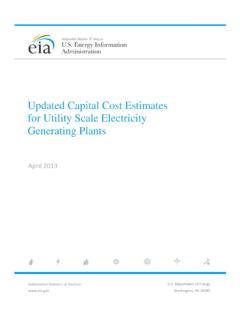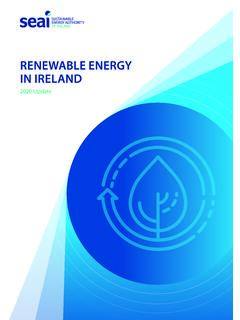Transcription of SOIL SCREENING GUIDANCE: USER'S GUIDE
1 United StatesOffice of Solid Waste andPublication ProtectionEmergency ResponseJuly 1996 AgencyWashington, DC 20460 SuperfundSoil SCREENING GUIDANCE: user s GuideSecond EditionEPA/540/R-96/018 July 1996 soil SCREENING GUIDANCE: user s GuideSecond EditionOffice of Emergency and Remedial Environmental Protection AgencyWashington, DC 20460 ACKNOWLEDGMENTSThe development of this guidance was a team effort led by the staff of the Office of Emergency and Remedial Response. David Cooper served as Team Leader for the overall effort. Marlene Berg coordinated the series of Outreach meetings withinterested parties outside the Agency. Sherri Clark, Janine Dinan and Loren Henning were the principal authors. Paul Whiteof EPA's Office of Research and Development provided tremendous support in the development of statistical approaches tosite technical assistance was provided by several contractors.
2 Robert Truesdale of Research Triangle Institute (RTI)led their team effort in the development of the Technical Background Document under EPA Contract 68-W1-0021. CraigMann of Environmental Quality Management, Inc. (EQ) provided expert support in modeling inhalation exposures underEPA Contract 68-D3-0035. Dr. Smita Siddhanti of Booz-Allen & Hamilton, Inc. provided technical support for the finalproduction of the user s GUIDE and Technical Background Document under EPA Contract addition, the authors would like to thank all EPA, State, public and peer reviewers whose careful review and thoughtfulcomments contributed to the quality of this document. iDISCLAIMERN otice: The soil SCREENING guidance is based on policies set out in the Preamble to the Final Rule of the national Oil andHazardous Substances Pollution Contingency Plan (NCP), which was published on March 8, 1990 (55 Federal Register8666).
3 This guidance document sets forth recommended approaches based on EPA s best thinking to date with respect to soilscreening. This document does not establish binding rules. Alternative approaches for SCREENING may be found to be moreappropriate at specific sites ( , where site circumstances do not match the underlying assumptions, conditions and modelsof the guidance ). The decision whether to use an alternative approach and a description of any such approach should beplaced in the Administrative Record for the site. Accordingly, if comments are received at individual sites questioning theuse of the approaches recommended in this guidance , the comments should be considered and an explanation provided for theselected approach. The soil SCREENING guidance : Technical Background Document (TBD) may be helpful in responding tosuch policies set out in both the soil SCREENING guidance : user s GUIDE and the supporting TBD are intended solely asguidance to the Environmental Protection Agency (EPA) personnel; they are not final EPA actions and do notconstitute rulemaking.
4 These policies are not intended, nor can they be relied upon, to create any rights enforceable by anyparty in litigation with the United States government. EPA officials may decide to follow the guidance provided in thisdocument, or to act at variance with the guidance , based on an analysis of specific site circumstances. EPA also reserves theright to change the guidance at any time without public OF INTRODUCTION .. of soil SCREENING Levels .. of soil SCREENING guidance .. soil SCREENING PROCESS .. 1: Developing a Conceptual Site Model .. Existing Site Data .. and Analyze Existing Site Data .. a Preliminary Diagram of the CSM .. Site Reconnaissance .. 2: Comparing CSM to SSL Scenario .. Pathways Present at the Site Addressed by guidance .
5 Additional Pathways Present at the Site Not Addressed by guidance .. Available Data to Background .. Step 3: Defining Data Collection Needs for Soils .. the Site Based on Existing Data .. Sampling and Analysis Plan for Surface soil .. Sampling and Analysis Plan for Subsurface Soils .. Sampling and Analysis Plan to Determine soil Characteristics .. Analytical Methods and Establish QA/QC Protocols .. 4: Sampling and Analyzing Site Soils & DQA .. Area and Depth of Source .. DQA Using Sample Results .. the CSM .. 5: Calculating Sitespecific SSLs .. Equations--Surface Soils .. Equations--Subsurface Soils .. Exposure to Multiple Chemicals .. Step 6: Comparing Site soil Contaminant Concentrations to Calculated SSLs.
6 7: Addressing Areas Identified for Further Study .. 36 REFERENCES .. Site Model Summary .. SCREENING DQOs for Surface Soils and Subsurface Soils .. Properties for SSL Development .. and Human Health Benchmarks Used for SSL Development .. D-1iiiLIST OF EXHIBITSE xhibit 1 Conceptual Risk Management Spectrum for Contaminated soil .. 2 Exhibit 2 Exposure Pathways Addressed by SSLs .. 4 Exhibit 3 Key Attributes of the user s GUIDE .. 4 Exhibit 4 soil SCREENING Process .. 6 Exhibit 5 Data Quality Objectives Process .. 10 Exhibit 6 Defining Study Boundaries .. 11 Exhibit 7 Designing Sampling and Analysis Plan for Surface Soils .. 13 Exhibit 8 Designing Sampling and Analysis Plan for Subsurface Soils .. 15 Exhibit Department of Agriculture soil Texture Classification.
7 19 Exhibit 10 Site-Specific Parameters for Calculating Subsurface SSLs .. 25 Exhibit 11Q/C Values by Source Area, City, and Climatic Zone .. 27 Exhibit 12 Simplifying Assumptions for SSL Migration to Ground Water Pathway .. 29 Exhibit 13 SSL Chemical with Non-carcinogen Toxic Effects on Specific Target Organ/Systems .. 34ivLIST OF ACRONYMSARARA pplicable or Relevant and Appropriate RequirementASTMA merican Society for Testing and MaterialsCERCLAC omprehensive Environmental Response, Compensation and Liability ActCLPC ontract Laboratory ProgramCSMC onceptual Site ModelCVCoefficient of VariationDAFD ilution Attenuation FactorDNAPLD ense Nonaqueous Phase LiquidDQAData Quality AssessmentDQOData Quality ObjectiveEAExposure AreaEPAE nvironmental Protection AgencyHBLH ealth Based LimitHEASTH ealth Effects Assessment Summary TableHELPH ydrological Evaluation of Landfill PerformanceHHEMH uman Health Evaluation ManualHQHazard QuotientIRISI ntegrated Risk Information SystemISC2 Industrial Source Complex ModelMCLM aximum Contaminant LevelMCLGM aximum Contaminant Level GoalNAPLN onaqueous Phase LiquidNOAELNo-Observed-Adverse-Effect LevelNPLN ational Priorities ListNTISN ational Technical Information ServiceOERRO ffice of Emergency and Remedial ResponsePA/SIPreliminary
8 Assessment/Site InspectionPCBP olychlorinated BiphenylPEFP articulate Emission FactorPRGP reliminary Remediation GoalQ/CSite-Specific Dispersion ModelQA/QCQuality Assurance/Quality ControlQLQuantitation LimitRAGSRisk Assessment guidance for SuperfundRCRAR esource Conservation and Recovery ActRfCReference ConcentrationRfDReference DoseRIRemedial InvestigationRI/FSRemedial Investigation/Feasibility StudyRMER easonable Maximum ExposureRODR ecord of DecisionSABS cience Advisory BoardSAPS ampling and Analysis PlanSPLPS ynthetic Precipitation Leaching ProcedureSSLSoil SCREENING LevelTBDT echnical Background DocumentTCLPT oxicity Characteristic Leaching Department of AgricultureVFVolatilization FactorVOCV olatile Organic soil SCREENING guidance is a tool that the Protection Agency (EPA) developedto help standardize and accelerate the evaluation andcleanup of contaminated soils at sites on theNational Priorities List (NPL) with future residentialland This guidance provides a methodology forenvironmental science/engineering professionals tocalculate risk-based, site-specific, soil screeninglevels (SSLs) for contaminants in soil that may beused to identify areas needing further investigationat NPL sites.
9 SSLs are not national cleanup standards. SSLsalone do not trigger the need for response actions ordefine unacceptable levels of contaminants in this guidance , SCREENING refers to the process ofidentifying and defining areas, contaminants, andconditions, at a particular site that do not requirefurther Federal attention. Generally, at sites wherecontaminant concentrations fall below SSLs, nofurther action or study is warranted under theComprehensive Environmental Response,Compensation and Liability Act (CERCLA). (SomeStates have developed SCREENING numbers that aremore stringent than the generic SSLs presented here;therefore, further study may be warranted underState programs.) Generally, where contaminantconcentrations equal or exceed SSLs, further studyor investigation, but not necessarily cleanup, iswarranted.
10 SSLs are risk-based concentrations derived fromequations combining exposure informationassumptions with EPA toxicity data. This user sGuide focuses on the application of a simple site-specific approach by providing a step-by-stepmethodology to calculate site-specific SSLs and ispart of a larger framework that includes both genericand more detailed approaches to calculatingscreening levels. The Technical BackgroundDocument (TBD) (EPA, 1996), provides moreinformation about these other approaches. GenericSSLs for the most common contaminants found atNPL sites are included in the TBD. Generic SSLs arecalculated from the same equations presented in thisguidance, but are based on a number of defaultassumptions chosen to be protective of humanhealth for most site conditions.















